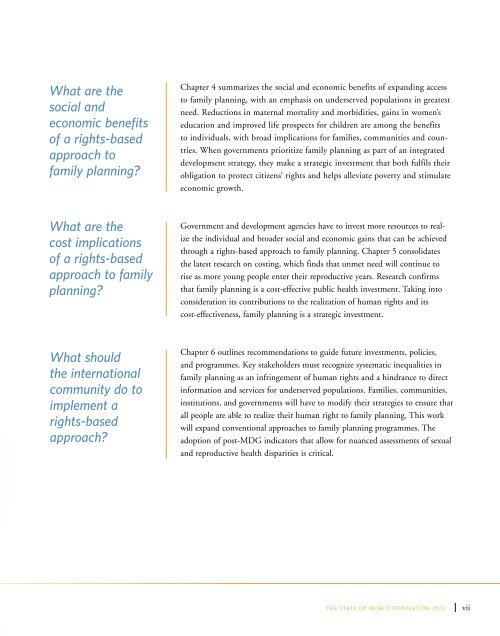State of World Population 2012 - Country Page List - UNFPA
State of World Population 2012 - Country Page List - UNFPA
State of World Population 2012 - Country Page List - UNFPA
Create successful ePaper yourself
Turn your PDF publications into a flip-book with our unique Google optimized e-Paper software.
What are the<br />
social and<br />
economic benefits<br />
<strong>of</strong> a rights-based<br />
approach to<br />
family planning<br />
Chapter 4 summarizes the social and economic benefits <strong>of</strong> expanding access<br />
to family planning, with an emphasis on underserved populations in greatest<br />
need. Reductions in maternal mortality and morbidities, gains in women’s<br />
education and improved life prospects for children are among the benefits<br />
to individuals, with broad implications for families, communities and countries.<br />
When governments prioritize family planning as part <strong>of</strong> an integrated<br />
development strategy, they make a strategic investment that both fulfils their<br />
obligation to protect citizens’ rights and helps alleviate poverty and stimulate<br />
economic growth.<br />
What are the<br />
cost implications<br />
<strong>of</strong> a rights-based<br />
approach to family<br />
planning<br />
Government and development agencies have to invest more resources to realize<br />
the individual and broader social and economic gains that can be achieved<br />
through a rights-based approach to family planning. Chapter 5 consolidates<br />
the latest research on costing, which finds that unmet need will continue to<br />
rise as more young people enter their reproductive years. Research confirms<br />
that family planning is a cost-effective public health investment. Taking into<br />
consideration its contributions to the realization <strong>of</strong> human rights and its<br />
cost-effectiveness, family planning is a strategic investment.<br />
What should<br />
the international<br />
community do to<br />
implement a<br />
rights-based<br />
approach<br />
Chapter 6 outlines recommendations to guide future investments, policies,<br />
and programmes. Key stakeholders must recognize systematic inequalities in<br />
family planning as an infringement <strong>of</strong> human rights and a hindrance to direct<br />
information and services for underserved populations. Families, communities,<br />
institutions, and governments will have to modify their strategies to ensure that<br />
all people are able to realize their human right to family planning. This work<br />
will expand conventional approaches to family planning programmes. The<br />
adoption <strong>of</strong> post-MDG indicators that allow for nuanced assessments <strong>of</strong> sexual<br />
and reproductive health disparities is critical.<br />
THE STATE OF WORLD POPULATION <strong>2012</strong><br />
vii
















